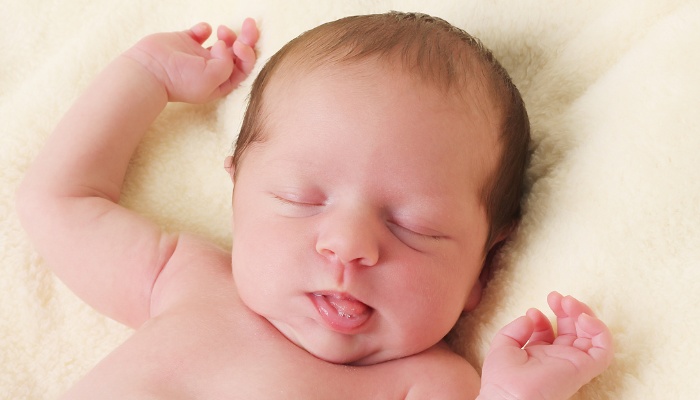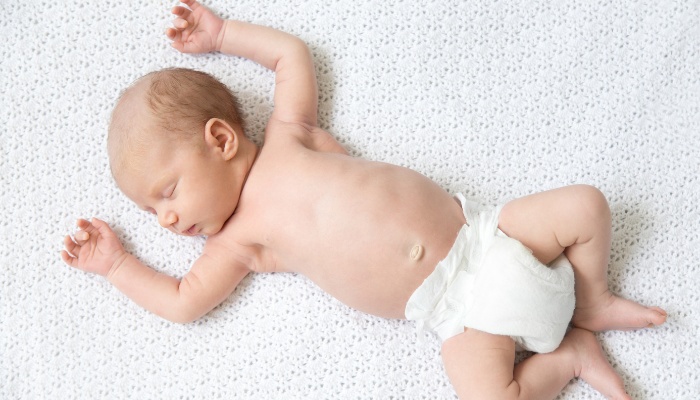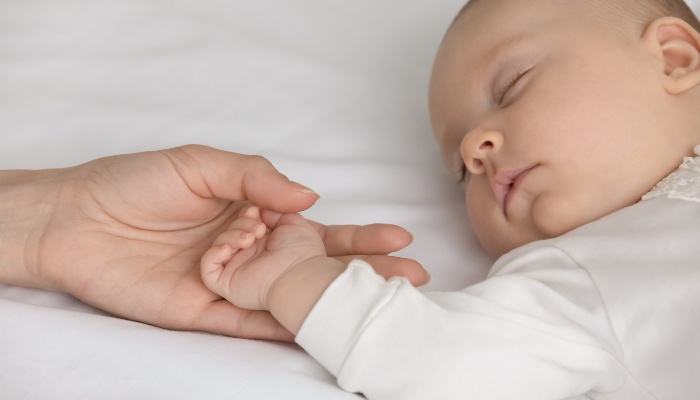Babies often sleep with their arms raised because it is a natural and comfortable posture for them, especially after being cramped in the womb.
Sleeping with arms raised also helps them feel secure in preventing the Moro Reflex from startling them.
The Sleepy Bub offers this tip:
“Finding what works best for your baby is paramount. If your baby prefers an arms up swaddling technique, then you should take your baby’s lead. Being a new parent can be challenging enough without adding sleep deprivation into the mix!”
While the position of your baby’s arms doesn’t really matter, the way in which you lay them down certainly does! Back to sleep every time!
My twins loved to stretch out in this adorable, angelic way, and their pediatrician assured me that sleeping with their arms thrown over their heads is perfectly normal.
Now that they’re older, I still find them sleeping like this every so often!
Table of Contents
Why Babies Sleep With Their Arms Up
There are 3 main reasons behind your baby’s need to sleep with their arms above their head, but it basically comes down to comfort and a natural biological response.
1. Naturally Comfortable Position
An arms-up sleeping position can simply be a more suitable, comfortable position for your little one.
They may raise their arms to help air circulate if they feel too warm, or they are simply experimenting with different sleeping positions, just as adults do.
Babies sleeping on their backs are quite limited as to what they can do, so extending their arms is one way of changing things up.
An arms-up position also might enable your little one to breathe easily and help with symptoms of reflux.
2. Feel Secure With Arms on Firm Surface To Prevent Moro Reflex
Babies often sleep with their arms above their heads to let them know they are resting on a firm surface.
This is to help reduce the chances of the Moro Reflex startling them awake.
The Moro Reflex is an involuntary response in all infants that usually disappears after the first two months of life.
When your baby is sleeping in their crib instead of your protective arms, they can feel as if they are about to fall. This protective reflex startles babies into waking.
This is a common reason for your baby crying out in the night as this rude awakening can be quite alarming for them.
Sometimes, after babies have startled, their arms will remain in an upward position as they drift back to sleep.
Fortunately, many babies gradually learn to soften the effects of this reflex by spreading their arms and fingers on the surface to reassure them of their safety.
3. Enjoy Being Able To Stretch Out After Being in the Womb
When you’ve been curled up on the couch or sat at your desk for several hours, a stretch feels great, right?
Well, your baby is making up for several months of being bunched up in their fetal position in the womb!
As a result, your newborn will often stretch out their limbs during sleep as they now have a chance to get things moving as they should (whether this is to enjoy a stretch itself or help pass gas and stimulate their bowels).
Is It Safe for Babies To Sleep With Their Arms Up?
Absolutely! This is a perfectly normal sleeping style in early infancy and is a safe position.
As long as you are following the current safe-sleep guidelines, it’s fine to let your baby sleep on his back with his arms over his head.

Safe Sleep Guidelines
Knowing the current guidelines for safe infant sleep is critical for your child’s well-being.
- Back to Sleep: Always place infants on their backs to sleep for all sleep times, including naps and at night.
- Firm Sleep Surface: Use a firm mattress in a safety-approved crib, bassinet, or portable crib covered by a fitted sheet. Avoid soft surfaces like couches, armchairs, or soft bedding.
- No Loose Bedding: Keep the sleeping area free of pillows, blankets, bumper pads, stuffed animals, and toys. Use a wearable blanket, swaddle, or sleep sack for warmth.
- Room Sharing, Not Bed Sharing: Share your room with your baby, but avoid bed-sharing. Use a separate sleep space like a crib or bassinet near your bed.
- Avoid Overheating: Dress your baby in sleep clothing like a one-piece sleeper, and avoid using too many layers or overheating the room.
- No Smoking, Alcohol, or Drug Exposure: Keep the sleep environment smoke-free, and avoid alcohol or illicit drug use during pregnancy and after birth.
- Breastfeeding is Recommended: If possible, breastfeed your baby. Breastfeeding has been associated with a reduced risk of Sudden Infant Death Syndrome (SIDS).
- Pacifier Use at Naptime and Bedtime: Consider offering a pacifier at naptime and bedtime, but don’t force it if your baby doesn’t want it.
- Avoid Products Claiming to Reduce SIDS Risk: Do not rely on commercial devices or products that claim to reduce the risk of SIDS. These have not been proven to be effective.
- Regular Physician Care: Ensure that your baby receives regular well-child check-ups.
Creating a Comfortable Sleep Environment for Your Baby
Creating a comfortable sleep environment for an infant involves several key considerations to ensure their safety, comfort, and well-being.
Here’s a guide on how to do it:
1. Choosing the Right Sleep Space
Select a safety-approved crib, bassinet, or Pack ‘n Play with a firm mattress.
Ensure that the mattress fits snugly within the frame, leaving no gaps that could pose a risk to the baby.
Use a fitted sheet designed for the specific dimensions of the sleep surface to keep it secure.
2. Optimal Temperature
Maintain a comfortable room temperature, typically between 68-72 degrees Fahrenheit (20-22 degrees Celsius).
Dress your baby appropriately for the room’s temperature to prevent overheating.
3. Eliminating Hazards and Distractions
Remove any loose bedding, pillows, stuffed animals, bumper pads, or toys from the sleeping area.
These items can pose suffocation risks and are unnecessary for a safe sleep environment.
Keep the sleep space simple and free from potential choking or entanglement hazards.
4. Ensuring Proper Ventilation
Ensure good airflow in the room, but avoid direct drafts on the baby.
A well-ventilated room helps maintain a fresh and comfortable sleeping environment.
5. Soft Lighting and Soothing Sounds
Use soft, ambient lighting or nightlights that provide a comforting glow without being too bright.
Some infants find white noise machines or gentle lullabies soothing, which can create a calming atmosphere conducive to sleep. (I highly recommend the Hatch Rest+)
6. Maintaining a Consistent Routine
Establishing a predictable bedtime routine can signal to your baby that it’s time to wind down and prepare for sleep.
This routine may include activities like feeding, bathing, reading, and cuddling.
7. Safe Sleep Position
Always place your baby on their back to sleep, both for naps and at night.
This reduces the risk of Sudden Infant Death Syndrome (SIDS) and ensures unobstructed breathing.
8. Room Sharing, Not Bed Sharing
Share your room with your baby, but avoid bed-sharing. Place the crib, bassinet, or Pack ‘n Play near your bed for easy access during the night.

Infant Sleep Positions
It’s perfectly natural and safe for babies to exhibit different sleeping positions in terms of their arm placement (up like a starfish or by their sides soldier-like).
What’s important is ensuring their general sleeping position is following safe sleep guidelines.
Best Sleeping Position for Newborn
Placing babies to sleep on their backs (not their bellies or sides) on a firm, flat surface is the recommended sleeping position.
This greatly reduces the risk of SIDS (Sudden Infant Death Syndrome) caused by reduced airflow and inhaling exhaled air when placed on their front.
Starfish Position
This perfectly safe position is one of the most common infant sleeping poses and sees babies extend their arms and legs out wide and spread their fingers out.
On Back With Full Swaddle
Infants find it soothing to sleep in swaddling material as this mimics the cozy closeness of the womb.
As swaddling allows you to tuck their arms close to their body, this sleeping style also helps prevent jerky movements in your little one that may startle them awake.
It is vitally important that swaddling stops once they show signs of starting to roll onto their stomach (usually around 3 months old).
On Back Swaddled With Arms Above Head
Some babies prefer to have their arms free from the swaddling blanket or sleep sack so they can rest their arms near their faces or above their heads.
Following the instructions of the swaddling product you use, the material would be tucked under their armpit instead of over their shoulders for arms-free sleeping.
Sleeping With Head to Side
A flat spot can develop on one side or the back of a newborn’s head when they sleep in the same position routinely.
Sleeping with the head turned to one side is fine as long as the baby is on their back.
If your baby strongly prefers one side to the other, gently move your baby’s head to the other side every so often.
Limiting the amount of time baby spends on their back with tummy time and holding them during the day can help reduce the chances of a flat spot developing and improve neck support.
Best Sleeping Position for Baby After Feeding
Pediatricians advise that babies be placed on their backs to sleep after feeding.
The Sleep Foundation reminds parents, “To facilitate digestion, keep the baby in an upright position for at least half an hour after feeding.”
Some parents have voiced concerns that back-sleeping risks their infant choking on their own vomit after feeding, but research shows that this isn’t very likely since babies naturally cough up or swallow fluid to clear their airways and that back-sleeping actually helps with this reflex.
Best Sleeping Position for Babies With Gas
Burp your baby before placing him or her on their back. Keep your baby in an upright position for 30 minutes before laying them down.
While on their back, encourage a more comfortable sleep by gently massaging their belly or by slowly cycling their legs toward their stomach like a bicycle.
Related Questions:
Why Do Babies Sleep With Their Legs Up?
It’s very common for newborn babies to sleep with their legs up in a frog-like position as this is similar to their close, tucked-up position in the womb and is how they feel most comfortable.
This is perfectly normal, and they will adopt a straighter leg position as their bodies develop.
What Age Does the Moro Reflex Disappear?
According to the American Academy of Pediatrics, the Moro Reflex in infants typically peaks at one month of age and gradually starts to disappear after about two months.
However, it is normal for this reflex to last up until 4 months post-natal and is later replaced by the adult “startle” reflex.
Mom of three (including identical twin boys), wife, and owner of Parents Wonder. This is my place to share my journey as a mother and the helpful insights I learn along the way.

